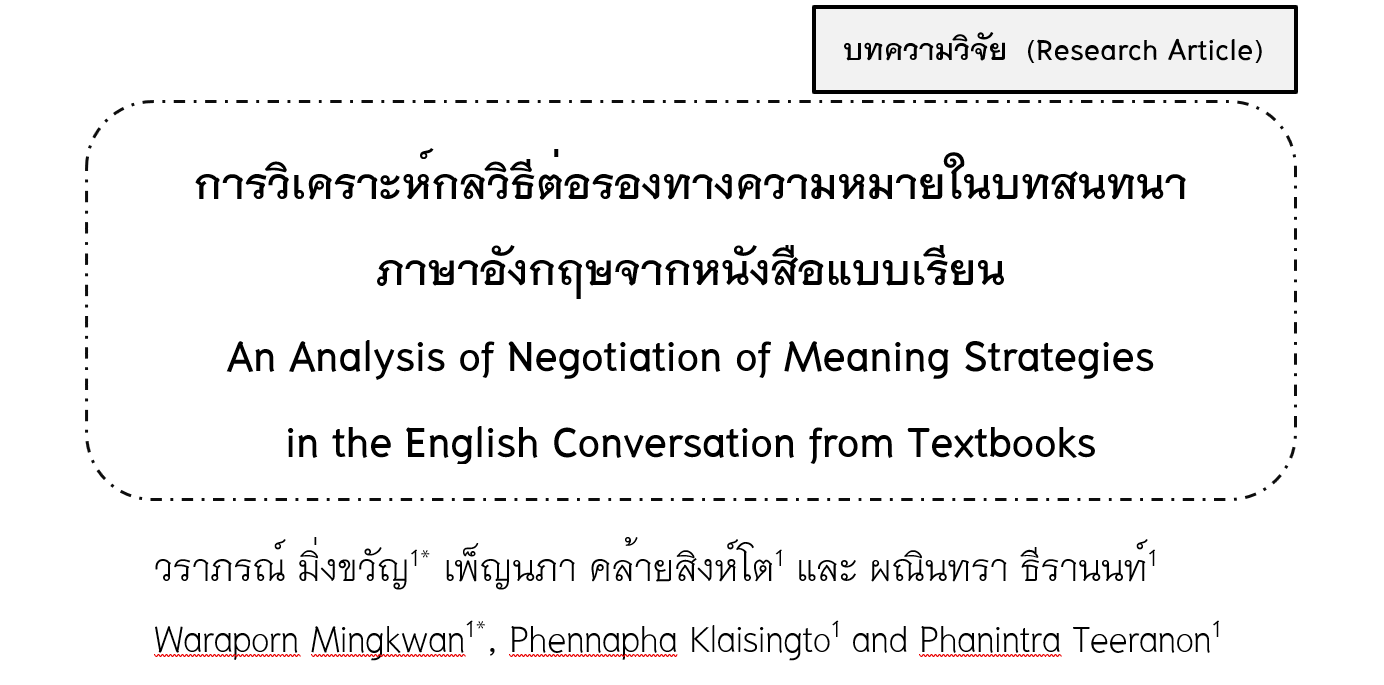An Analysis of Negotiation of Meaning Strategies in the English Conversation from Textbooks
Keywords:
Negotiation of Meaning Strategies, Communicative Competence, English Conversation, TextbooksAbstract
Communicative competence is an important factor for the second language (L2) learners to succeed in their real-life communication. One of the most critical characteristics of communication used is the negotiation of meaning. The characteristics also include various strategies for facilitating second language acquisition and promoting mutual understanding among L2 learners. The purpose of this study was to analyze the negotiation of meaning strategies observed in the English conversations in textbooks. The data used in this study was 47 conversations from textbooks. As this was a descriptive research, the data and extracts identified in each strategy were analyzed using Long's (1998) theoretical framework and prior studies from Sommath (2007) and Champakaew (2013) to analyze the covert negotiation of meaning strategies in conversations. The data was statistically analyzed using frequency and percentage. The results showed that there were 107 times of negotiation of meaning found in 5 strategies; 45 times for Confirmation Checks (42.1%), 32 times for Clarification Requests (29.9%), 21 times for Repetitions (19.6%), 6 times for Comprehension Checks (5.6%), and only 3 times for Appeals for Help (2.8%). The results suggested the conversations in textbooks revealed the varied negotiation of meaning strategies depending on the communicative circumstances that would be the guideline for language instructors. Instructors can not only apply these strategies to their English learning activities for communication, but they can also provide L2 learners with a short-term training course to help them develop their English communicative skills.
References
Alijanian, E., Ketabi, S., & Moinzadeh, A. (2018). The study of interaction features used by intermediate Iranian EFL learners in their lexical language related episodes. Journal of Language Teaching and Research, 9(5), 1053-1058.
Champakaew, W. (2013). The Effectiveness of negotiation of meaning strategies in two-way communication tasks for oral proficiency and grammatical development of higher education level students. 1 Chiang Mai University.
Champakaew, W., & Pencingkarn, W. (2014). The Effectiveness of negotiation of meaning strategies on developing grammar usage in two-way communication tasks. - Journal of Humanities and Social Sciences, 3(1), 87-114. From https://so05.tci-thaijo.org/index.php/MFUconnexion/article/view/241398.
Charalambous, A. C. (2011). The Role and Use of Course Books in EFL. Online Submission. From https://eric.ed.gov/?id=ED524247.
Gass, M. S., & Mackey, A. (2006). Introduction: Special Issue Interaction Research: Extending the Methodological Bounderies. Studies in Second Language Acquisition, 28(2), 169-178.
Gass, S. & Varonis, E. (1985b). Variation in native speaker speech modification to nonnative speakers, Studies in Second Language Acquisition, 7, 37-58.
Hartono, R. (2017). A critical review of research on negotiation of meaning insecond language learning. Global Expert: Jurnal Bahasa dan Sastra, 6(1). From http://ejournal.uigm.ac.id/index.php/GE/article/view/257.
Lekwilai, P. (2016). Using reader’s theater to develop reading fluency among Thai EFL students. Pasaa Paritat, 31, 163-188. from https://www.culi.chula.ac.th/publicationsonline/files/article2/7kf21u1IDcThu24233.pdf.
Long, M. H. (1983a) Linguistic and conversational adjustments to nonnative speakers, Studies in Second Language Acquisition, 5, 177-194.
Long, M. H. (1983b) Native Speaker/nonnative speaker conversation in the second language Classroom, In M.A. Clarke and J. Handscombe (eds) TESOL’82, Pacific Perspectives on Language Learning and Teaching, 207-225.
Long, M. H. (1998). Focus on form in task-based language teachin. University of Hawai’i Working Papers in ESL.
Oliver, R. (2002) The patterns of negotiation for meaning in child interactions, The Modern Language Journal, 86.
Palma, G. (2014). A classroom view of negotiation of meaning with EFL adult Mexican pupils. Sage Open, 4(2), 2158244014535941. From https://doi.org/10.1177%2F2158244014535941.
Pica, T. & Doughty, C. (1985a). Input and interaction in the communicative language classroom: A comparison of teacher-fronted and group activities. In S. M. Gass & C. G. Madden (Eds.) Input in second language acquisition, Rowley, MA: Newbury House, 115-132.
Richards, J. C. (2001). Curriculum Development in Language Teaching. Cambridge: Cambridge University Press.
Sommath, S. (2007). The effects of the patterns of negotiation of meaning strategies on the English language used in communicative information gap tasks by Thai lower secondary school students. (Doctoral dissertation). Nakorn Ratchsima: Suranaree University of Technology.
Stempleski S. (2019). Stretch 2A. Oxford: Oxford University Press.
Stempleski S. (2018). Stretch 2B. Oxford: Oxford University Press.

Downloads
Published
How to Cite
Issue
Section
License
Copyright (c) 2022 Phayao University

This work is licensed under a Creative Commons Attribution-NonCommercial-NoDerivatives 4.0 International License.
ผู้นิพนธ์ต้องรับผิดชอบข้อความในบทนิพนธ์ของตน มหาวิทยาลัยพะเยาไม่จำเป็นต้องเห็นด้วยกับบทความที่ตีพิมพ์เสมอไป ผู้สนใจสามารถคัดลอก และนำไปใช้ได้ แต่จะต้องขออนุมัติเจ้าของ และได้รับการอนุมัติเป็นลายลักษณ์อักษรก่อน พร้อมกับมีการอ้างอิงและกล่าวคำขอบคุณให้ถูกต้องด้วย
The authors are themselves responsible for their contents. Signed articles may not always reflect the opinion of University of Phayao. The articles can be reproduced and reprinted, provided that permission is given by the authors and acknowledgement must be given.







